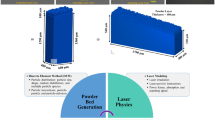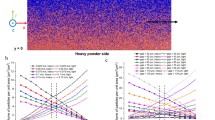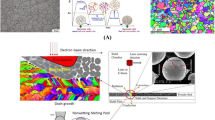Abstract
In this study, a physics-based analytical thermal modeling method is proposed for the estimation of temperature distribution, molten pool geometries, and vapor depression size in keyhole melting mode of laser powder bed fusion (LPBF) metal additive manufacturing, considering the influence of laser spot size. A closed-form thermal model is developed to consider the complex mechanisms of laser powder absorption in keyhole melting mode, which consists of two heat sources. A moving circular heat source solution is employed to calculate the temperature increase caused by the laser powder absorbed in the keyhole mouth due to the thermal effects of plasma. A moving cylindrical heat source solution with finite length is employed to calculate the temperature rise due to the laser powder absorbed by the keyhole walls. The radius of the circular and cylindrical heat sources is equal to the laser spot radius. The total temperature distribution in the keyhole mode is the superposition of the results of two heat source solutions. The geometries of molten pool and vapor depression are then determined by comparing the calculated temperature profile with the melting point and boiling point of the material, respectively. The proposed analytical thermal model has been experimentally validated. The predictions of molten pool size and vapor depression depth show good agreement with experimental results of Ti6Al4V in LPBF. The analytical modeling method has high computational efficiency because no finite element-based numerical calculations are incorporated in this method. Thus, the proposed analytical model will become a low-cost tool to help the researchers conduct rapid simulation of the melting process in LPBF and avoid the expensive trial-and-errors in experimental investigations.









Similar content being viewed by others
Data availability
Not applicable.
Code availability
Not applicable.
References
Cunningham R, Zhao C, Parab N, Kantzos C, Pauza J, Fezzaa K, Sun T, Rollett AD (2019) Keyhole threshold and morphology in laser melting revealed by ultrahigh-speed x-ray imaging. Science 363(6429):849–852
Acharya R, Sharon JA, Staroselsky A (2017) Prediction of microstructure in laser powder bed fusion process. Acta Mater 1(124):360–371
Khairallah SA, Anderson AT, Rubenchik A, King WE (2016) Laser powder-bed fusion additive manufacturing: Physics of complex melt flow and formation mechanisms of pores, spatter, and denudation zones. Acta Mater 15(108):36–45
Martin AA, Calta NP, Khairallah SA, Wang J, Depond PJ, Fong AY, Thampy V, Guss GM, Kiss AM, Stone KH, Tassone CJ (2019) Dynamics of pore formation during laser powder bed fusion additive manufacturing. Nat Commun 10(1):1
Ronneberg T, Davies CM, Hooper PA (2020) Revealing relationships between porosity, microstructure and mechanical properties of laser powder bed fusion 316L stainless steel through heat treatment. Mater Des 1(189):108481
Hizi W, Rahmouni H, Gorji NE, Guesmi A, Ben Hamadi N, Khezami L, Dhahri E, Khirouni K, Gassoumi M (2022) Impact of Sintering Temperature on the Electrical Properties of La0. 9Sr0. 1MnO3 Manganite. Catalysts 12(3):340
Sanaei N, Fatemi A (2020) Analysis of the effect of surface roughness on fatigue performance of powder bed fusion additive manufactured metals. Theoret Appl Fract Mech 1(108):102638
Zhang W, Tong M, Harrison NM (2020) Scanning strategies effect on temperature, residual stress and deformation by multi-laser beam powder bed fusion manufacturing. Addit Manuf 1(36):101507
Patel S, Vlasea M (2020) Melting modes in laser powder bed fusion. Materialia 1(9):100591
Tenbrock C, Fischer FG, Wissenbach K, Schleifenbaum JH, Wagenblast P, Meiners W, Wagner J (2020) Influence of keyhole and conduction mode melting for top-hat shaped beam profiles in laser powder bed fusion. J Mater Process Technol 1(278):116514
King WE, Barth HD, Castillo VM, Gallegos GF, Gibbs JW, Hahn DE, Kamath C, Rubenchik AM (2014) Observation of keyhole-mode laser melting in laser powder-bed fusion additive manufacturing. J Mater Process Technol 214(12):2915–2925
Promoppatum P, Yao SC, Pistorius PC, Rollett AD (2017) A comprehensive comparison of the analytical and numerical prediction of the thermal history and solidification microstructure of Inconel 718 products made by laser powder-bed fusion. Engineering 3(5):685–694
Ning J, Wang W, Zamorano B, Liang SY (2019) Analytical modeling of lack-of-fusion porosity in metal additive manufacturing. Appl Phys A 125(11):1–1
Wang W, Garmestani H, Liang SY (2021) Prediction of Upper Surface Roughness in Laser Powder Bed Fusion. Metals 12(1):11
Tang M, Pistorius PC, Beuth JL (2017) Prediction of lack-of-fusion porosity for powder bed fusion. Addit Manuf 1(14):39–48
Huang Y, Fleming TG, Clark SJ, Marussi S, Fezzaa K, Thiyagalingam J, Leung CL, Lee PD (2022) Keyhole fluctuation and pore formation mechanisms during laser powder bed fusion additive manufacturing. Nat Commun 13(1):1–1
Dilip JJ, Zhang S, Teng C, Zeng K, Robinson C, Pal D, Stucker B (2017) Influence of processing parameters on the evolution of melt pool, porosity, and microstructures in Ti-6Al-4V alloy parts fabricated by selective laser melting. Progress in Additive Manufacturing 2(3):157–167
Ye J, Khairallah SA, Rubenchik AM, Crumb MF, Guss G, Belak J, Matthews MJ (2019) Energy coupling mechanisms and scaling behavior associated with laser powder bed fusion additive manufacturing. Adv Eng Mater 21(7):1900185
Gong H, Rafi K, Gu H, Starr T, Stucker B (2014) Analysis of defect generation in Ti–6Al–4V parts made using powder bed fusion additive manufacturing processes. Addit Manuf 1(1):87–98
Guo C, Xu Z, Zhou Y, Shi S, Li G, Lu H, Zhu Q, Ward RM (2021) Single-track investigation of IN738LC superalloy fabricated by laser powder bed fusion: Track morphology, bead characteristics and part quality. J Mater Process Technol 1(290):117000
Karayagiz K, Elwany A, Tapia G, Franco B, Johnson L, Ma J, Karaman I, Arróyave R (2019) Numerical and experimental analysis of heat distribution in the laser powder bed fusion of Ti-6Al-4V. IISE Transactions 51(2):136–152
Arısoy YM, Criales LE, Özel T (2019) Modeling and simulation of thermal field and solidification in laser powder bed fusion of nickel alloy IN625. Opt Laser Technol 1(109):278–292
Zhang Z, Huang Y, Kasinathan AR, Shahabad SI, Ali U, Mahmoodkhani Y, Toyserkani E (2019) 3-Dimensional heat transfer modeling for laser powder-bed fusion additive manufacturing with volumetric heat sources based on varied thermal conductivity and absorptivity. Opt Laser Technol 109:297–312
Bayat M, Thanki A, Mohanty S, Witvrouw A, Yang S, Thorborg J, Tiedje NS, Hattel JH (2019) Keyhole-induced porosities in Laser-based Powder Bed Fusion (L-PBF) of Ti6Al4V: High-fidelity modelling and experimental validation. Addit Manuf 1(30):100835
Wang W, Ning J, Liang SY (2021) In-situ distortion prediction in metal additive manufacturing considering boundary conditions. Int J Precis Eng Manuf 22(5):909–917
Wang W, Garmestani H, Liang SY (2022) Prediction of molten pool size and vapor depression depth in keyhole melting mode of laser powder bed fusion. Int J Adv Manuf Technol 119(9):6215–6223
Sow MC, De Terris T, Castelnau O, Hamouche Z, Coste F, Fabbro R, Peyre P (2020) Influence of beam diameter on Laser Powder Bed Fusion (L-PBF) process. Addit Manuf 1(36):101532
Carslaw HS, Jaeger JC (1959) Conduction of heat in solids. Clarendon Press
Gladush GG, Smurov I (2011) Physics of laser materials processing: theory and experiment. Springer Science & Business Media
Gong H, Gu H, Zeng K, Dilip JJ, Pal D, Stucker B (2014) Melt pool characterization for selective laser melting of Ti-6Al-4V pre-alloyed powder. In2014 International Solid Freeform Fabrication Symposium. University of Texas at Austin
Wang YM, Kamath C, Voisin T, Li Z (2018) A processing diagram for high-density Ti-6Al-4V by selective laser melting. Rapid Prototyp J
Kiss AM, Fong AY, Calta NP, Thampy V, Martin AA, Depond PJ, Wang J, Matthews MJ, Ott RT, Tassone CJ, Stone KH (2019) Laser-induced keyhole defect dynamics during metal additive manufacturing. Adv Eng Mater 21(10):1900455
Author information
Authors and Affiliations
Corresponding authors
Ethics declarations
Ethics approval
Not applicable.
Consent to participate
Not applicable.
Consent for publication
Not applicable.
Conflict of interest
The authors declare no competing interests.
Additional information
Publisher's Note
Springer Nature remains neutral with regard to jurisdictional claims in published maps and institutional affiliations.
Rights and permissions
Springer Nature or its licensor (e.g. a society or other partner) holds exclusive rights to this article under a publishing agreement with the author(s) or other rightsholder(s); author self-archiving of the accepted manuscript version of this article is solely governed by the terms of such publishing agreement and applicable law.
About this article
Cite this article
Wang, W., Liang, S.Y. Physics-based analytical modeling of keyhole mode in laser powder bed fusion. Int J Adv Manuf Technol 123, 2809–2818 (2022). https://doi.org/10.1007/s00170-022-10263-7
Received:
Accepted:
Published:
Issue Date:
DOI: https://doi.org/10.1007/s00170-022-10263-7




